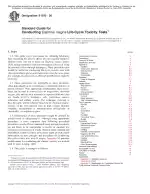ASTM E1193-20 PDF Download
Standard EN SampleStandard Guide for Conducting Daphnia magna Life-Cycle Toxicity Tests
Also Known As:
Significance and Use
5.1Â Protection of an aquatic species requires prevention of unacceptable effects on populations in natural habitats. Toxicity tests are conducted to provide data that may be used to predict what changes in numbers and weights of individuals might result from similar exposure to the test material in the natural aquatic environment. Information might also be obtained on the effects of the material on the health of the species.
5.2Â Results of life-cycle tests with D. magna are used to predict chronic effects likely to occur on daphnids in field situations as a result of exposure under comparable conditions.
5.2.1Â Life-cycle tests with D. magna are used to compare the chronic sensitivities of different species, the chronic toxicities of different materials, and study the effects of various environmental factors on the results of such tests.
5.2.2Â Life-cycle tests with D. magna are used to assess the risk of materials to aquatic organisms (see Guide E1023) or derive water quality criteria for aquatic organisms (1).3
5.2.3Â Life-cycle tests with D. magna are used to extrapolate the results of chronic toxicity tests on the same test material with the same species in another water or with another species in the same or a different water. Most such predictions take into account the results of acute toxicity tests, and so the usefulness of the results of a life-cycle test with D. magna may be increased by reporting the results of an acute toxicity test (see Guide E729) conducted under the same conditions. In addition to conducting an acute toxicity test with unfed D. magna, it may be relevant to conduct an acute test in which the daphnids are fed the same as in the life-cycle test to see if the presence of that concentration of that food affects the results of the acute test and the acute-chronic ratio (ACR) (see 10.3.1).
5.2.4Â Life-cycle tests are used to evaluate the biological availability of, and structure-activity relationships between, test materials and test organisms.
5.3Â Results of life-cycle tests with D. magna might be influenced by temperature (2), quality of food, composition of dilution water, condition of test organisms, test media (for example, water hardness), and other factors.
| Descriptors | life-cycle toxicity test, Daphnia magna,Aquatic Organisms,Aquatic Toxicology,Environmental Impact Assessment,Toxicity Test |
| ICS Codes | 07.100.20 - Microbiology of water 13.020.30 - Environmental impact assessment |
| Language(s) | English |
| File Size | 256.0 KB |


